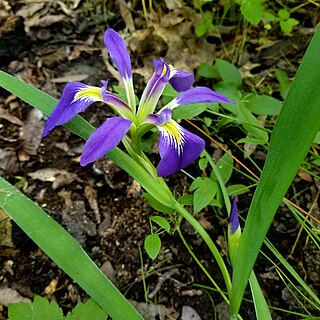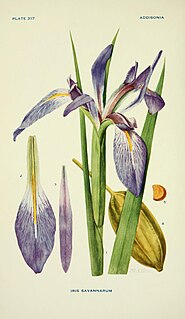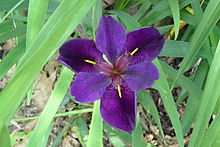
Iris is a genus of 260–300 species of flowering plants with showy flowers. It takes its name from the Greek word for a rainbow, which is also the name for the Greek goddess of the rainbow, Iris. Some authors state that the name refers to the wide variety of flower colors found among the many species. As well as being the scientific name, iris is also widely used as a common name for all Iris species, as well as some belonging to other closely related genera. A common name for some species is 'flags', while the plants of the subgenus Scorpiris are widely known as 'junos', particularly in horticulture. It is a popular garden flower.
The music of Louisiana can be divided into three general regions: rural south Louisiana, home to Creole Zydeco and Old French, New Orleans, and north Louisiana. The region in and around Greater New Orleans has a unique musical heritage tied to Dixieland jazz, blues, and Afro-Caribbean rhythms. The music of the northern portion of the state starting at Baton Rouge and reaching Shreveport has similarities to that of the rest of the US South.

Solanum nelsonii, common names pōpolo and Nelson's horsenettle, is a partially woody sprawling shrub-like perennial plant in the family Solanaceae, part of the Solanum or nightshade genus. This poisonous plant is endemic to the Pacific Islands. It grows low in coastal sites in coral rubble to pure sand.

Parula was formerly a small genus of New World warblers which breed in North and South America.

Iris giganticaerulea, the giant blue iris, is a species of iris, in the subgenus Limniris, in the series Hexagonae. It is a rhizomatous perennial, from northern America. It has long bright green leaves, very tall stems and one or two musky fragrant flowers in a range of blue shades or rarely white.

Iris lacustris, the dwarf lake iris, is a plant species in the genus Iris, subgenus Limniris and in the section Lophiris. It is a rhizomatous, beardless perennial plant, native to the Great Lakes region of eastern North America. It has lavender blue or violet-blue flowers, a very short stem and long fan-like green leaves. It is cultivated as an ornamental plant in temperate regions. It is closely related to Iris cristata.
Warren Storm was an American drummer and vocalist, known as a pioneer of the musical genre swamp pop; a combination of rhythm and blues, country and western, and Cajun music and black Creole music.
The Delta National Wildlife Refuge is located 10 miles (16 km) east of Venice, Louisiana along the Mississippi River. The area formed when a breach in the natural levee of the Mississippi River occurred in 1862 approximately 100 miles (160 km) below New Orleans, Louisiana. The 48,000-acre (190 km2) refuge was purchased in 1935 with the primary purpose to provide sanctuary and habitat to wintering waterfowl. Access is by boat only.
Dypsis brevicaulis is a species of flowering plant in the Arecaceae family. It is a dwarf palm found on only three sites in Madagascar, with fewer than fifty plants ever found in the wild. The plant is part of the IUCN Sampled Red List Index for Plants, a study of representative species from all over the world which is studying extinction trends for plants.

Palmetto Island State Park is a recent addition to the Louisiana State Park system. The new state park is located south of Abbeville, Louisiana in Vermilion Parish. The state of Louisiana acquired the property for the park in 1981 but did not begin construction on it with the intent of public use until 2002. State budget constraints and other concerns delayed the park's opening until October 28, 2010.

The fauna of Louisiana is characterized by the region's low swamplands, bayous, creeks, woodlands, coastal marshlands and beaches, and barrier islands covering an estimated 20,000 square miles, corresponding to 40 percent of Louisiana's total land area. Southern Louisiana contains up to fifty percent of the wetlands found in the Continental United States, and are made up of countless bayous and creeks.
Ira Schreiber Nelson (1911–1965) was an American botanist, working in Louisiana.
Swamp iris is a common name for several plants and may refer to:

Iris brevicaulis is a species in the genus Iris, it is also in the subgenus Limniris and in the series Hexagonae. It is a rhizomatous perennial, from North America. It has bright green, glossy long leaves, a long zig-zagged stem and 3–6 flowers per stem, which are come in blue shades from violet-blue, to lavender, to purple-blue, to bright blue to blue, and pale blue.

Lowell Fitz Randolph was an American scientist, in the field of genetics, botany and horticulture. He was a Cornell University graduate who became Professor of Botany and was also employed as an associate cytologist for the United States Department of Agriculture. He was also an avid iris collector and wrote a book on the Iris genus. He carried out important research into plant chromosomes of iris, orchid genus and corn plants. He was sometimes known as "Fitz" by his many friends and associates.

Iris fulva, also known as copper iris, is a species in the genus Iris, it is also in the subgenus Limniris and in the series Hexagonae. It is a rhizomatous perennial, endemic to the southern and central United States. It has copper-red to deep red flowers and bright green leaves.

Iris hexagona, commonly known as the Dixie iris, is a species in the genus Iris, it is also in the subgenus Limniris and in the series hexagonae. It is a rhizomatous perennial with long bright green leaves, long thin stem and has small groups of flowers in shades of blue, from violet, to bluish purple, to lavender. It flowers in springtime and is native to the southeastern and south-central US states.
Iris nelsonii is a species in the genus Iris, it is also in the subgenus Limniris and in the series hexagonae. It is a rhizomatous perennial, from northern America. It has long drooping, grass-like leaves, tall stems, 10 red-purple flowers.

Iris savannarum is a species in the genus Iris, it is also in the subgenus Limniris and in the series hexagonae. It is a rhizomatous perennial.

Introgressive hybridization, also known as introgression, is the flow of genetic material between divergent lineages via repeated backcrossing. In plants, this backcrossing occurs when an generation hybrid breeds with one or both of its parental species.















